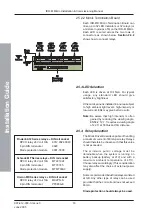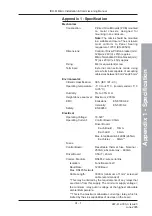
IDR-M Mimic Installation & Commissioning Manual
Appendix 2 - Batter
y Calculations
A2 - 2
997-412-000-3, Issue 3
June 2005
Calculating Battery Capacity
During the quiescent period it is reasonable to assume that
the minimum voltage from the battery will be 24V for the vast
majority of the time.On this premise the 24V supply figure can
be used for all systems during this period.
In alarm the final battery voltage may fall to 19V. Allowing up
to 1V for cable and other losses, the worst-case supply voltage
for non-boosted systems may be as low as 18V. This results
in higher currents in alarm for these systems.
At present, Notifier Panels/ PSUs fall into the following groups:
Boosted: ID2000, ID2008, ID/NF3000, NF300
Non-Boosted: ID50, ID1000, PS2, PS2/CMX
If the relays are driven from the panel’s auxiliary supply, then
the Control and Driver PCB supply currents should be included
in the panel’s battery calculations, together with the relay
currents.
A fully-loaded, non-boosted panel/ PSU will require the following
battery capacity to support the Mimic Driver:
C = ((T x Iq) + Ia ) x 1.25
where:
C
is the calculated battery capacity in Ampere-Hours
T
is the required battery backup time in Hours
lq
is the IDR-M mimic quiescent current in Amperes
la
is the IDR-M mimic alarm current in Amperes
1.25
is a multiplying constant to comply with LPS1014
A quick guide is given on the previous page for a basic system,
assuming NO LEDs are lit in quiescent and ALL are lit in alarm.
Note that:
a. If the control matrix causes some LEDs to be lit during
quiescent, specific calculations must be carried out to
ensure adequate battery capacity.
b. If relays are used (or a combination of LEDs and relays),
the appropriate values should be substitued into the tables.
c. If connected to the auxiliary output of a boosted panel, the
efficiency of the panel’s booster must be allowed for.
Notifier recommend using the Loop and Battery Calculator Tool
to calculate the total battery capacity required.


































